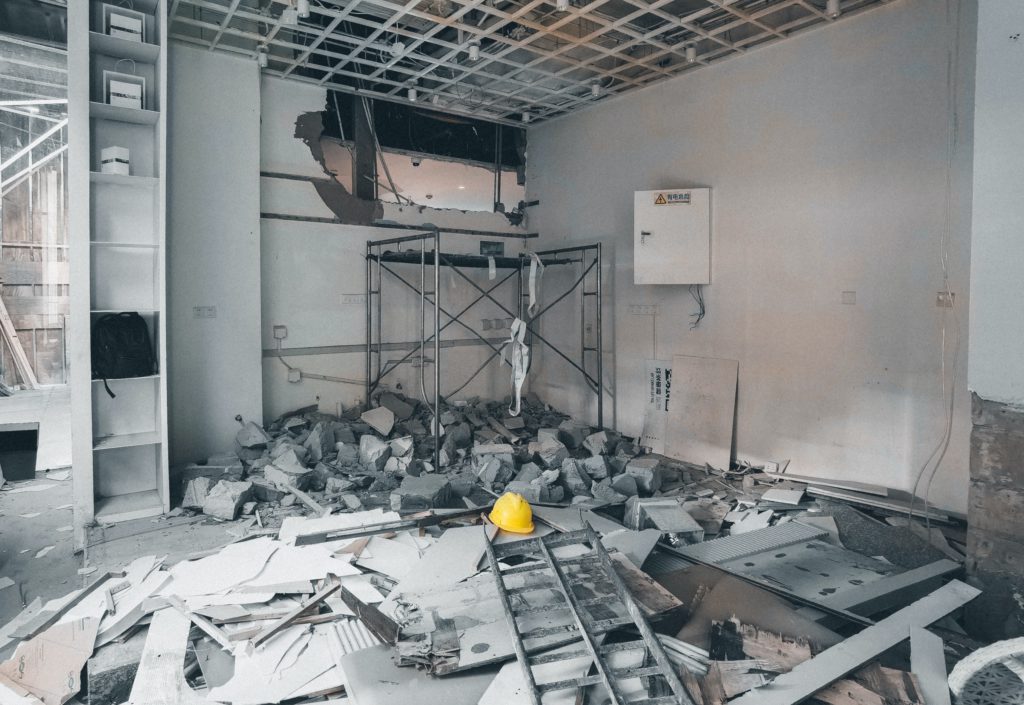Concrete Removal

Jun/08/21
No one likes having broken, cracking, and crumbling concrete on their property. Not only does it lower curb appeal, it can be unsafe for anyone walking on it. Even though concrete can stay in good shape for years with proper upkeep, most homeowners will have to deal with removing concrete at some point. But removing concrete slabs is a tricky, time-intensive, and dangerous process for inexperienced DIY home renovators.
Unless you’re trained to use heavy machinery, large concrete removal projects should always be done by professional contractors. But that shouldn’t stop property owners from learning about the best concrete removal practices and issues to watch for with their concrete patio, sidewalk, or driveway. Let’s dive into some common topics our team at A-Core often runs into during concrete removal projects.
Concrete Removal vs. Resurfacing
With proper upkeep, concrete can last for years. But most concrete patios, driveways, and sidewalks will develop structural issues over time. So how do you know when those cracks and crumbles in your concrete are fixable, or if you need to have the slabs removed and replaced? Some common signs you need to have your concrete removed include:
Deep and wide surface cracks. If your concrete has large surface cracks, those structural issues cannot be fixed by resurfacing the slab. Cracked concrete should be removed and replaced.
Significant settling. Tree roots, earthquakes and tremors, and soil settling can significantly move concrete slabs to the point where they’re difficult to walk on. If this is the case, it should be replaced after the soil underneath has been leveled out.
Signs of spalling. Spalling is when the concrete surface is severely flaking and needs to be replaced. This is usually due to weather, corrosion, excessive rolling pressure, and large impacts.
Signs of frost heave. Sometimes, the moisture in soil can freeze in cold temperatures and cause the ground to swell upwards. This often disturbs concrete or other objects on the surface. If the frost heave is significant, it could break the concrete slab and require removal.
Should I Remove Concrete By Myself?
It can be difficult figuring out whether to tackle a concrete removal project by yourself or if you need some more experienced hands on the job. There are a few things to consider before attempting to remove concrete alone—take a look at the concrete you’re removing and ask these questions:
How thick are the concrete slabs? Slabs less than four inches thick can often be broken and removed without using heavy machinery. The removal of concrete slabs thicker than four inches requires special tools and previous concrete removal experience.
Are you working with reinforced concrete? Removing concrete often requires power tools to cut through the thick slabs—cutting through reinforced concrete can be dangerous if you’re not trained to do it safely. If you’re not sure if the concrete is reinforced, try breaking off an edge piece or expand an existing crack to spot any internal reinforcement bars or mesh. Reinforced concrete with wire mesh or rebar inside requires electric saws and other tools that only professionals should operate.
Are there hidden utility lines underneath the concrete? DIY concrete removal risks the digger hitting buried cables, wires, and pipes. Breaking those underground utilities can be extremely dangerous. You should always call 811 before breaking ground on your property to make sure you’re clear of any utility lines. If there are underground utilities underneath your concrete, don’t try to remove it yourself. Leave the removal to the professionals so everyone stays safe.
How to Break Up Concrete
If you decide to remove concrete by yourself, safety should be your top priority. Make sure you’re using proper safety equipment like eye protection and dust masks so you can stay safe during the removal process. If there are parts of the DIY removal you don’t feel comfortable doing, don’t be afraid to call concrete removal specialists like A-Core. We regularly provide concrete removal help to all types of customers, so we know how to do the job efficiently and safely. Both commercial and residential concrete removal projects will require several tools:
-
- Sledgehammers
- Jackhammer
- Shovel
- Safety goggles
- Tough gloves
- Dust mask
- Earplugs
- Pry bar
- Bolt cutters
- Pickaxe
- Heavy-duty buckets
One problem inexperienced concrete removers will run into is how to properly get rid of the broken concrete pieces from your property after the removal process is complete. Concrete can’t go in your trash can, and many trash removal services won’t remove concrete debris because of its heavy weight. Most concrete construction companies—like A-Core—provide removal services for residential and commercial properties, so the broken pieces are discarded safely.
Our Concrete Removal Service Areas
A-Core provides efficient concrete removal services to customers across the United States. If you operate in one of the following areas, our team is more than happy to provide quality concrete removal services for any size construction or concrete demolition project you may have:
-
- Arizona
- Colorado
- Idaho
- Montana
- New Mexico
- Oregon
- Texas
- Utah
- Washington
Let A-Core Take Care Of Your Concrete Removal Project
A-Core can safely break up, remove, and replace concrete for residential and commercial projects. Since opening in 1974, A-Core has been a trusted partner in the concrete construction and demolition industry. We’ve helped countless businesses with their concrete removal and restoration needs, and are confident we can help you with your upcoming project. Contact our team today to learn more about how we can assist you in your upcoming concrete removal projects.